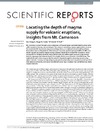Identificador persistente para citar o vincular este elemento:
https://accedacris.ulpgc.es/jspui/handle/10553/42451
| Campo DC | Valor | idioma |
|---|---|---|
| dc.contributor.author | Geiger, Harri | en_US |
| dc.contributor.author | Barker, Abigail K. | en_US |
| dc.contributor.author | Troll, Valentin R. | en_US |
| dc.date.accessioned | 2018-11-14T11:29:06Z | - |
| dc.date.available | 2018-11-14T11:29:06Z | - |
| dc.date.issued | 2016 | en_US |
| dc.identifier.issn | 2045-2322 | en_US |
| dc.identifier.other | Scopus | - |
| dc.identifier.uri | https://accedacris.ulpgc.es/handle/10553/42451 | - |
| dc.description.abstract | Mt. Cameroon is one of the most active volcanoes in Africa and poses a possible threat to about half a million people in the area, yet knowledge of the volcano's underlying magma supply system is sparse. To characterize Mt. Cameroon's magma plumbing system, we employed mineral-melt equilibrium thermobarometry on the products of the volcano's two most recent eruptions of 1999 and 2000. Our results suggest pre-eruptive magma storage between 20 and 39 km beneath Mt. Cameroon, which corresponds to the Moho level and below. Additionally, the 1999 eruption products reveal several shallow magma pockets between 3 and 12 km depth, which are not detected in the 2000 lavas. This implies that small-volume magma batches actively migrate through the plumbing system during repose intervals. Evolving and migrating magma parcels potentially cause temporary unrest and short-lived explosive outbursts, and may be remobilized during major eruptions that are fed from sub-Moho magma reservoirs. | en_US |
| dc.language | eng | en_US |
| dc.relation.ispartof | Scientific Reports | en_US |
| dc.source | Scientific Reports [ISSN 2045-2322], v. 6 (33629) | en_US |
| dc.subject | 250621 Vulcanología | en_US |
| dc.subject.other | Natural hazards | en_US |
| dc.subject.other | Petrology | en_US |
| dc.subject.other | Volcanology | en_US |
| dc.subject.other | Mount-Cameroon | en_US |
| dc.subject.other | Melt Inclusions | en_US |
| dc.subject.other | Active Volcano | en_US |
| dc.subject.other | West-Africa | en_US |
| dc.subject.other | Cape-Verde | en_US |
| dc.subject.other | Thermobarometry | en_US |
| dc.subject.other | Intrusion | en_US |
| dc.subject.other | Deposits | en_US |
| dc.title | Locating the depth of magma supply for volcanic eruptions, insights from Mt. Cameroon | en_US |
| dc.type | info:eu-repo/semantics/article | en_US |
| dc.type | Article | en_US |
| dc.identifier.doi | 10.1038/srep33629 | en_US |
| dc.identifier.scopus | 2-s2.0-84990177275 | - |
| dc.identifier.isi | 000391998100001 | - |
| dc.contributor.authorscopusid | 57189242224 | - |
| dc.contributor.authorscopusid | 23987776300 | - |
| dc.contributor.authorscopusid | 6602449850 | - |
| dc.identifier.eissn | 2045-2322 | - |
| dc.identifier.issue | 33629 | - |
| dc.relation.volume | 6 | en_US |
| dc.investigacion | Ciencias | en_US |
| dc.type2 | Artículo | en_US |
| dc.contributor.daisngid | 7016164 | - |
| dc.contributor.daisngid | 1656410 | - |
| dc.contributor.daisngid | 278032 | - |
| dc.description.numberofpages | 10 | en_US |
| dc.utils.revision | Sí | en_US |
| dc.contributor.wosstandard | WOS:Geiger, H | - |
| dc.contributor.wosstandard | WOS:Barker, AK | - |
| dc.contributor.wosstandard | WOS:Troll, VR | - |
| dc.date.coverdate | Octubre 2016 | en_US |
| dc.identifier.ulpgc | Sí | es |
| dc.description.sjr | 1,625 | |
| dc.description.jcr | 4,259 | |
| dc.description.sjrq | Q1 | |
| dc.description.jcrq | Q1 | |
| dc.description.scie | SCIE | |
| item.fulltext | Con texto completo | - |
| item.grantfulltext | open | - |
| Colección: | Artículos | |
Citas SCOPUSTM
16
actualizado el 08-jun-2025
Citas de WEB OF SCIENCETM
Citations
13
actualizado el 08-jun-2025
Visitas
63
actualizado el 16-sep-2023
Descargas
67
actualizado el 16-sep-2023
Google ScholarTM
Verifica
Altmetric
Comparte
Exporta metadatos
Los elementos en ULPGC accedaCRIS están protegidos por derechos de autor con todos los derechos reservados, a menos que se indique lo contrario.
